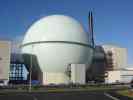|
Caithness.org News Bulletins |
||
| Dounreay News Index | Caithness.org News Index | Front Page Archives |
|
£30 MILLION ALLIANCE TO REMOVE BREEDER FUEL FROM
DFR 15 August 2002
Five companies have formed an alliance with the UK Atomic Energy Authority to remove the last remaining nuclear material from Dounreay's experimental fast reactor, DFR. This latest alliance is in addition to the one announced in February 2002 The package of work is expected to take until 2008 to complete at an estimated cost of £30 million. It is expected to create 50 jobs at the site and is a key element in a programme worth an estimated £250 million to decommission the reactor.
Mr Wilson said: "This is the latest in a series of contracts the UK Atomic Energy Authority has let in the last few years to decommission DFR that are bringing real benefits to the economy of this area. And in the longer term, these contracts give firms in the region experience and opportunities to build their presence in the growing marketplace for nuclear decommissioning services in the UK through alliances and skills transfers with some of the leading companies in Britain and Europe. "With some £75 million a year from the decommissioning and site restoration of Dounreay now flowing into the economy of the Highlands and Islands alone, site restoration is not just good for the environment but good for the economy as well." Dounreay site director Peter Welsh said: "Today's announcement is further evidence of the real progress we are making to decommission DFR and deliver our promise to restore the environment of the site." DFR operated from 1958 until 1977. In the early 1980s, nearly all the fuel was removed from the reactor and about a third of the uranium breeder blanket that surrounded the core was also taken out. The alliance announced today is for the removal of the other 977 breeder elements and the last remaining experimental fuel assembly. Between five and 10 per cent of the 977 elements have distorted because of neutron exposure and are stuck in the reactor. The alliance announced today will use remote retrieval and cutting equipment to remove the last of the fuel from the reactor. It will be sent to a new treatment facility to be built beside DFR where the material will be cleaned of any residual liquid metal coolant and packaged in containers. The five companies in the alliance with UKAEA are Strachan & Henshaw (mechanical engineering), Framatome ANP (retrieval and tooling equipment), SGN (process plant) Atkins Nuclear (safety and environment) and Alstec (plant operations). UKAEA estimates it will take until 2013-2022 to complete stages one and two decommissioning of DFR. This includes the removal and destruction of the liquid metal coolant (NaK), decommissioning of the DFR fuel pond, removal of the breeder fuel, and removal and cleaning of the NaK-wetted primary circuits, at a estimated cost in the region of £173 million. The total estimated cost of complete decommissioning of DFR by 2026-2042 is in the region of £250 million. No decision has been taken on the future management of the breeder fuel once it has been removed. Today's announcement is for the removal of the fuel from the reactor to enable such a decision to be implemented. Some 1500 activities required to
decommission Dounreay over a 50-60 year period at a cost in the region of
£4 billion are contained in the Dounreay Site Restoration Plan, which can
be viewed at The Dounreay Fast Reactor (DFR), which operated from 1959 until 1977, used an alloy of sodium-potassium (NaK) as its coolant. Seventy-three tonnes of the liquid metal was removed from its secondary circuit shortly after its closure but 57 tonnes remain in the primary circuit. A significant number of the 977 elements still in its breeder blanket are jammed. All fuel has been removed from the core except a single experimental fuel assembly.
|
||



